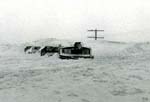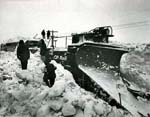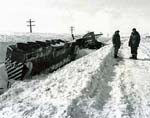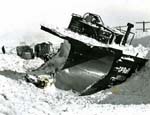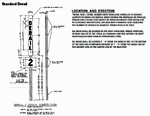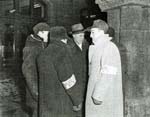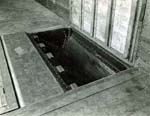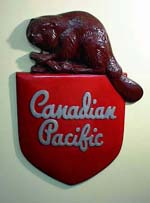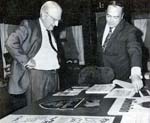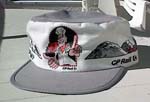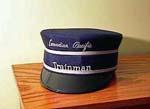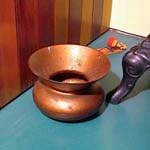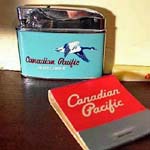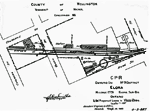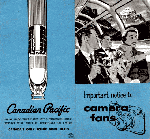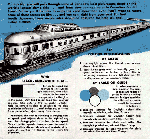 | Canadian Pacific Odds and Ends - Part 9 Articles |
The Big Blow of 1978 - A.B. Koenig 1978. The "Last Call" page has appeared weekly on OKthePK's web site over the past couple of years. Each week a different article told the story about various railway items of interest. While some of the articles were saved they were no longer available online. Several of those about the Canadian Pacific Railway have been compiled here on this page. There is insufficient room to display more than a few articles per page. As a result, "Canadian Pacific Odds and Ends - Part 9", continues this month with more possible parts to follow as time progresses. Every month they will be archived to the CPR Set-off Siding web site for future online retrieval. Look under the articles section on the CPR Set-off Siding web site to find these archived pages. 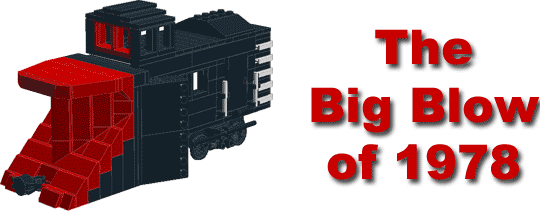 By A.B. Koenig 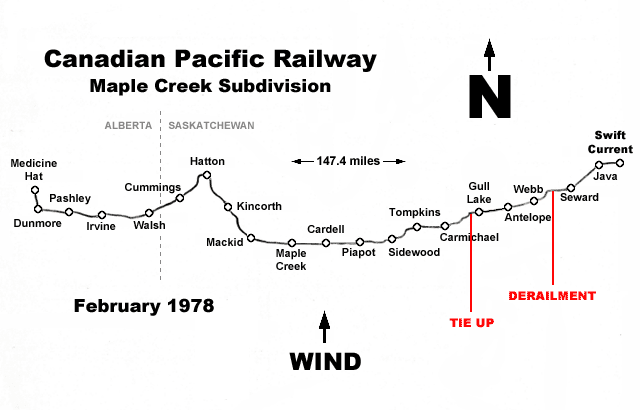 It was rather calm and peaceful as we boarded 940 on the eve of 4 February 1978. The temperature hung about the -18C mark, ice crystals sparkled in the headlight beam, and the exhaust vapor indicated a slight breeze from the southeast. Two big SD4O diesel units snaked over 80 cars up the east hill and wheeled through Dunmore on the regular run to Swift Current. Passing through Irvine we noticed snow being swept across the track ahead at ground level by a fairly sharp wind from the south. At Walsh the drifting subsided and it appeared that the wind had let up. I opened my window and looked about. Stars twinkled in a clear sky, the route was clear, and there was no wind. Train speed picked up to about 50 mph as we rolled toward Hatton, and then suddenly, we were in it again. This time the drifting snow was about headlight high and the wind was much stronger. As the gale caught the train broadside, the speed dropped to about 30 mph. The cab chilled and amperage rose with the occasional wheel slip. As we struggled through Hatton the pilot began to strike drifts. "If this stupid wind does not ease off, it is going to be a long trip," was the remark as the hands closed on the midnight hour. Approaching Maple Creek we were instructed by radio to stop and remain there until further notice on account of a westbound freight being stuck in drifts about a mile west of Gull Lake. According to the report, the storm was raging much worse further east, especially in the Gull Lake area. Two units were being dispatched out of Swift Current to assist the stuck train. After waiting about an hour we were cleared to proceed to Carmichael and to stay there until the line was open at Gull Lake. However, by now 952 was almost due at Maple Creek. The Operator contacted 952 by radio and was advised that he was between Hatton and Kincorth coming slowly in visibility that was almost nil. As we came out of the station with orders we noticed that the wind was stronger, and the green glow of the east signal was becoming quite dim, with conditions deteriorating, we began having second thoughts about leaving ahead of 952. Our train stretched out close to a mile and was becoming difficult to pull in the gale. The chances of making it through were not good. On the other hand, 952 had three big units and a shorter train. I don't appreciate getting "scooped", but tonight it would be better if 952 broke the way. After consulting with the conductor, it was decided to follow 952 out of Maple Creek. About 30 minutes passed before 952 showed up and rumbled by. As soon as he gave us the "yellow", we took off after him. We had rot gone a mile before we were enveloped in a blanket of blowing snow. The view forward was like looking at a white wall as a wild wind whipped volumes of snow at a rate well over 60 miles per hour. By maintaining radio contact with 952, we were able to stay right on his tail. The broken drifts had not enough time to reform and our passage was comparatively easy. 952 was taking the brunt of the storm and had reported that his lead unit was beginning to act up. Plowing snow has always been an attraction on the railway. Hitting mounds of soft snow at speed can create quite a show. It can even be rather exciting. On the old steamers it was usually a damp affair as snow struck and melted on the hot boiler. But on diesels, it is something else. Riding high on the point, one has a front row seat for the performance. Upon contact, drifts explode into huge billows scattering to the right-of-way fence. The deluge of snow streams down the windows at times blacking out the cab entirely, and showers on the roof with the roar of a hailstorm. When drifts become high, hard, and long, the game can get rough. Some can be so solid, that busting them is like hitting a brick wall. Tough slugging can drag the movement to the point of barely making it through. Windows and walk ways clog, doors are blocked, the whistle chokes, the headlight ices over, and the cab becomes wet and clammy. And then, there is the horror of stalling halfway through a long one. After leaving Tompkins, we received the alert that 952 had stopped at Carmichael between switches, and to watch for his tail end. Approaching blind, we crept slowly until his taillights were visible and halted about one hundred feet from the van. "The coffee pot is on," came the good news from 952's caboose. We sure wont turn down that invitation tonight. I set a hard brake and prepared to leave the cab. We forced the front door open and fought our way into the bone-chilling blow. Progress was very slow, and about halfway, a fierce gust almost hurled us into the ditch. After regaining our footing, we groped toward the light ahead. We finally grabbed the handrails and burst through the door with a blast of snow. "That's a real corker out there," said the conductor as he poured the steaming brew. "We just about did not make it," I gasped trying to catch my breath. The coffee hit the spot. We held onto the cups as the caboose was bounced and rocked by the shrieking tempest. Watching the coffee swirl in the mug, I pondered the situation. Every minute of delay worked in favor of the blow as it would be building drifts higher and higher. And we still had about 50 miles to go. Day was breaking when the radio crackled the message that the line was clear at Gull Lake. We fastened our parkas and made a hasty retreat to our units. We continued to follow the passage of 952 without any problems. It was a weary crew that crawled off 940 at Swift Current after about a twelve hour session. As the day wore on, the blow raged without let up. The passenger, number 1, which departed on our arrival, managed to make it as far an Antelope. It waited there for 902. However, 902 had lost its power plowing through the drift west of Gull Lake and was stalled. Units were rushed out to pull number 1 back to Swift Current and to bring in 902. All westbound traffic was held at Swift Current. Then came the Call: "Snowplow west for 16:30." The last snowplow that I can recall being on was during the steam days. They were quite the spectacle as they used to go charging along and then disappear in a cloud of snow, steam, and smoke. With the mild winters we have had in this area, a snowplow on our subdivision has been a rare sight. Without checking the record, the last time snowplows were used here for any appreciable amount of snow was in 1951 when a blizzard filled the cut east of Carmichael. A wind-beaten sun sank slowly behind a low grey roll of cloud as we gently coupled to the plow. The crew made the required connections and tested the equipment for operation. All doors and windows were closed and secured. After checking the headlight and whistle, the plow operator and his mate took their positions in the cupola. "Radio Check." "Loud and Clear. According to the plan, the snowplow would break the way for number 1 and four freight trains. The parade was ready to go and waiting patiently. We maneuvered to the main line and stopped at the station for any further orders. After a few nervous minutes the conductor emerged from the office. "Okay. Let's go." he yelled. We rolled slowly through the yard by the waiting procession and headed westward toward the blow. As we left the double track at Java (5 miles west of Swift Current) we struck the gale. Dark forms bobbed in the window of the plow as it lurched into the tempest. Only shallow drifts were encountered until we started up the hill to Webb. Then a voice boomed in the speaker: "Hit'er. Big drift ahead." I opened the throttle and braced for the impact. As the blade sliced through the mound, a load of snow was scooped up and hurled to the sides. The headlight cleared and we broke through without much effort. "Hit'er," came the order again. This one was worse. We reeled with the solid crunch as tons of packed drift were dislodged and heaved. The gale caught the load and drove it back bombarding us with a thunderous roar. When the front windows cleared, I was more than a little concerned about cracks appearing in the glass. If one of them broke, the cab would suddenly be very air-conditioned. With one hand on the throttle, the other on the brake, and an eye on the speedometer, we bucked through drift after drift. A tough one at Webb rocked us down to 10 miles per hour. The cab blacked out entirely and the only thing visible was the lights in the instrument panel. The cab became hot and humid. The floor was wet from snow sifting through the doors and windows. We rounded a bend and the lights of Gull Lake loomed up through the dense blow. We halted beside the station. The front cab door was blocked with snow and the side windows were froze shut. We were able to open the rear door to let in some fresh air. Red lights flashed nearby on Highway 41 which was declared closed to all traffic. I was advised by the conductor that there were some bad drifts just west of Gull Lake and that I would have to hit them hard. When everyone was back in position, I received the signal to proceed. As we passed the west switch I opened up. It was not a moment too soon before hitting a high one that almost stopped us cold. We were just breaking through when the shrill ring of the alarm bell pierced the cab and a red light flashed on the panel. I shut off and applied the brakes on full while the voice in the speaker bellowed: "Hit'er, a big drift ahead." We stopped. Fortunately we had not reached the next drift and were on clear track. The wind howled and screamed about us as it was realized that the lead unit was dead. I slowly scaled the heap of snow and ice packed on the side-walkway and made my way to the second unit. Upon reaching it I was very relieved to see that it was still running. To start the lead unit, we had to open a side door to operate the start switch. But, it was blocked shut with wet icy snow. We spent about ten minutes digging out the blockage and were finally able to open the door. Water dripped from my chin as driving snow struck my face and it was becoming difficult to see due to my eyelashes icing. I primed and turned the start switch. The engine room lights dimmed and then brightened as the engine fired. "Hooray! We're in business." With wet smiles we returned to the cab and checked the panel. Everything was normal and I reported that the trouble was corrected. I received the signal to back up slowly. In order to have the best run possible at the drift ahead, we edged backward until our caboose neared the drift behind. I shifted to forward and we took off wide open. We crashed into the wall with a complete black out in a barrage of snow. The needle dropped to 8 miles per hour... rose to about 15... back down to 10... as we wedged through what seemed to be an endless struggle. Then, the speed dipped below 5... and the wheel-slip light began blinking. I was not aware that we were even moving while a chorus of anxious voices screamed, "Hit'er. Keep her going." Then, with a surge we broke through leaving a cloud of whirling snow in our wake. The storm had eased considerably as we drifted into Maple Creek. We took time-out for a hot drink and lunch. Sipping hot coffee we listened to the progress of the procession as they relayed their positions to each other. All trains were making it through except the third freight had to reduce its train at Piapot on account of having unit trouble. We had a comparative easy run for the remainder of the trip arriving at Medicine Hat in the early morning. It was a pleasure to get home to dry out and I hoped that conditions would improve before the next call for duty. But it was not to be. The blow continued unabated. In some respects it was even worse. In the wild rampage, dirt was scooped up from fields that were swept bare and churned into a brown soup. Trains were running in packs led by snowplows. But the going was getting tougher. Each time the cuts were plowed, the banks piled higher. Some reached eye-level as they passed by the cab window. It was becoming impossible to throw the snow clear anymore while full effort was being required to drive through. And, the "brown sugar" kept drifting in, packing as hard as concrete. It was the evening of Tuesday, 7 Feb 1978, and a snowplow was leading a procession westward. The blow was in its usual form as they left Gull Lake. They struck the barrier and were hauled down to a stall. Attempts to pull free from the vice-like grip were of no avail. A radio report was sent to Gull Lake giving the approximate location of the stall. Swift Current was ordered to hold all trains. But one freight that followed the plow was nearing Gull Lake. When it arrived, it was instructed to run light to the stalled snowplow and to assist it through the drift. After difficult slugging through deep snow, they reached the plow and coupled to the caboose. They tugged, jerked, and bunted. But the full power of all units was unable to loosen the hold. It was then decided to pull the equipment out piece by piece starting with the caboose. The pin was pulled and they began moving back. Snow piled high behind and the movement jerked to a halt. They were able to move forward a short distance. Several runs were made at the block but they could not punch through. Finally, they could neither move forward nor backward. Particulars of the predicament were reported. Then, came the order: "Abandon the equipment." The blow howled and roared in the night, filling the cut, and slowly burying a snowplow, four units, and a caboose. The railway was tied-up. On Thursday, 9 Feb 1978, I was called to deadhead to Swift Current. As the main line was still blocked at Gull Lake we were transported by Company auto. Immediately after the movement ceased on Tuesday night, the heavy-weights were called in. They included bulldozers, large front-end loaders, and even a rotary plow from the mountains. By early Wednesday morning they began chopping and gnawing on the packed mounds of snow. A work force arrived armed with picks and shovels and started to dig out the trapped locomotives. By Thursday morning only one locomotive remained to be retrieved. The line would be open in a few hours. As they were preparing to pull the last locomotive out of the drift, a snowplow with three units was leaving Swift Current. In a snow-filled cut about two miles east of Webb they hit a solid wall. A rail snapped, the plow veered and headed up the north bank, and the three units dove into the ditch. The lead locomotive was sunk so deep, the shaken crew was obliged to crawl out through the cab window. A survey of the situation indicated that the railway was moved back to square one. Friday morning, 10 Feb 1978. I was called for the Moose Jaw auxiliary. After assembling the equipment and getting the Hook on our nose, we headed out toward the scene. The fleet had moved over from Gull Lake. Like ants on a hill, the loaders dashed down into the cut, took a thaw, then carried it out and spat it on piles near the fence. A work force composed of various crafts had joined the foray. All attention was focused on this latest casualty. Two locomotives and the plow were still in the ditch. The third unit had been pulled out and hoisted back on the rail by the Petibone mobile crane. The strategy was to pull the second unit to a location where the Petibone could re-rail it. The remainder of the morning was spent clearing and widening the cut. We took the Hook back to Seward and returned for the pull with four large locomotives. Also, while this activity was going on, a snowplow was punching its way between Gull Lake and the scene. If all went well, the line could be clear before the end of the day. At noon we responded to the thumbs-up signal and broke for dinner. The plates were well loaded with a good variety of tasty food. One remark that can be made about the Moose Jaw auxiliary is that it has one of the best diners on wheels. About two o'clock in the afternoon the preparation was nearing completion. Having finished their respective chores, groups of men assembled on the bank to watch the performance. Carmen were securing a cable to the second locomotive. When the last load was moved out, the signal was given to come ahead. we moved up slowly as the gallery looked on intently. After attaching the cable to the drawbar, the carmen scrambled up the bank. The Supervisor took his position and the chatter ceased. We gently took up the slack. "Okay. Give her snooce.". 12,000 horses leaned in their traces and the tug was on. Crack! We reared back suddenly as the cable snapped. "A good start." A loader lumbered down to the equipment car for a larger cable while the carmen removed the tattered shanks. "The new cable was attached and four units dug in their heels for another pull. Ease back, stretch, open up... the cable bristled with the strain. Crack! There was a whiplash of cable as the knuckle-pin broke. A fragment fired forward as if shot from a cannon and punctured the rear sand tank of the second locomotive. The Supervisor stared aghast at the sand pouring out of the hole. "Get another pin." Another pin was inserted and the stage was set for the third attempt. The amperage rose slowly... 800, 900, into the RED... Crack! The Supervisor shook his head as he examined the shredded cable. "Get the Hook." he ordered. While we were going for the Hook, it was reported that the snowplow from Gull Lake was on the ground in a drift at Webb. As there would not be anything to do at the scene for some time yet, the Petibone was sent to Webb to re-rail the plow. After spotting the Hook In position, carmen attached cables to the rear end of the second locomotive. With its boom high, the Hook began to loosen the icy clench. With picks, bars, and shovels, workmen set to the task of digging out the ice and snow that was packed in around the under gear. Dusk was closing in while we took the Hook back to Seward. Floodlights were set up and beamed into the cut as we moved in for another pull. The cable was attached. "Ease back." This time she has got to come. And sure enough, with very little persuasion, she came willingly out of her nest. "Steaks are on," came the call from the diner. It was timed just right. There was an air of excitement as we settled down to the steaming victuals. By the time we would be through with the steaks, the Petibone should have the unit re-railed. Then there would be only one to go. It was still possible to make the midnight deadline. On our return, the enthusiasm was chilled when we noticed that the unit had not even been touched. And there was no sign of the Petibone. We were then informed that while the Petibone was moving over to Webb, It hit a hole and broke its universal. That did it. With this setback, they decided to call it a day. Operations would resume in the morning. The Scene 11 Feb 1978. By noon, the Petibone had been repaired, the second locomotive was re-railed and out of the Way, the cut was completely cleaned out, and the Calgary auxiliary were having dinner at Gull Lake. As the remaining locomotive in the ditch was leaning at an awkward angle, they decided not to pull for fear it might tip. As the route was now cleared to the scene, the Calgary auxiliary had no trouble coming over. The Hooks were positioned at both ends of the locomotive. Anchors were set and blocked firm while cables were slung with utmost care. First, the unit would be raised and erected, and then it would be inched over to the track. Both Hooks operated as a team under the strict guidance of the Supervisor. A wrong move, or a move at the wrong time, could cost a whole day. In slow stages the locomotive was edged out of the ditch. Daylight was fading as the unit was finally lowered on the rail. Cables were retracted and wound on their spools. "Everything is clear." The Hooks retreated from the cut. All that remained to be done was track repair and general mopping up. And what was done with the snowplow that was part way up the bank? Well, as it originally wanted to climb out of the cut, they granted its wish and heaved it on top of the bank where it sat like some strange monument. At eleven o'clock in the evening the official message was sent: "The railway is clear for traffic." Early morning of 12 Feb 1978. We were on the way home on the first freight west. The railway looked like the aftermath of a battle. Demolished take-offs, uprooted crossing planks, and all sorts of debris were strewn along the right-of-way. Block signals were leaning with targets missing and some were just peeking over the banks. Back tracks and switches were blown over. And huge chunks of "brown sugar" were scattered along the route. Only three sidings between Swift Current and Maple Creek were usable. We squeezed through the narrow gorges with just inches to spare. Heads were kept inside as the jagged icy walls passed the window. Some of the banks were over twenty feet high. Passing through the channel west of Gull Lake was like being in a roof less tunnel. We highballed Maple Creek and left the ruins behind. And shortly before noon, we rolled into home base. The blow was over. In years ahead it will probably become another old-timer's tale. The freakish gale swept across the border from Montana striking at random in about a two hundred mile swath. Some areas were practically untouched. Throughout it all, Medicine Hat experienced nothing more than a breeze. It provided some excitement, and on occasion, considerable grief. Fortunately no one was seriously injured. There was even the odd laugh. In the final analysis, it did prove that an old-fashioned blow was still capable of stopping a railway dead in its track. 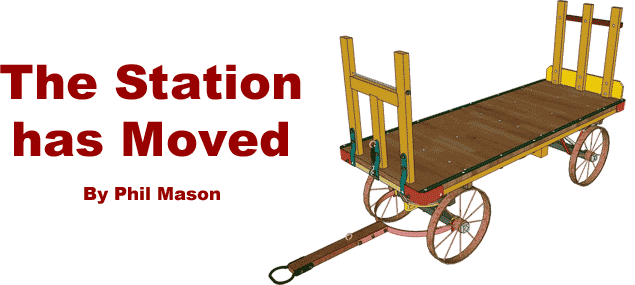 Castlegar British Columbia was the location where the Rossland Subdivision branched off the Boundary Subdivision. The Canadian Pacific Railway constructed a station there in 1902 which was unusual as it was built between the two legs of the wye junction. There are yard tracks which form the third side to this triangle. Both of these images show trains on the Boundary Subdivision. The first image, taken in 1974, shows the Nelson-Castlegar Kraft road switcher caboose stopped just beyond the train order signal. The conductor would be signing the train register which would free up the Nelson-Castlegar portion of the Boundary for other traffic. Typically, the Kraft switcher would operate as timetable scheduled train number 51 out of Nelson, the Boundary Sub. Freight for Grand Forks and Midway would operate as 53, and the Trail freight would operate as 55 as far as Castlegar, where it would operate over the Rossland Sub to the smelter at Tadanac. The second image shows a Boundary Sub freight passing Castlegar station in the 1980's. Note the train order board is gone, indicating that the train order/timetable operation has been replaced by the Manual Block System. The station has since been moved from between the legs of the wye to a street side location and serves as the Castlegar museum. The Rossland Sub remains active to Tadanac and Warfield. The Boundary Sub continues north for about 5 miles to serve the Kraft pulp mill and is abandoned beyond Westley. I thought I would also show you some images of trains near Castlegar from 1973. The next two photos show "Kraft Switcher" working the pulp mill at Kraft just west of Castlegar on the Boundary Sub. The switcher ran from Nelson early in the morning as timetable train number 51 then worked all day around Castlegar. The shot of the H-Liner is at Robson West. By 1973 it was simply the junction for the tracks serving the pulp mill but previously it was the interchange point between Canadian Pacific sternwheel steamers on the Columbia River and the Columbia & Western Railway (The Columbia & Western Railway later became CP's Boundary Sub). It was the southern terminus for the Arrow Lake steamers and an important link between the main line and the railways and mines of the Kootenays. The Celgar (Columbia Cellulose Celgar pulp mill, now several owners later but still producing) marks shift changes at the mill with the whistle from the S.S. Minto, the final steamship to serve the Arrow Lakes. This final photo shows the Nelson-Tadanac (Trail) "Hotshot", timetable train 55, at the junction in Castlegar. The other symbol for this freight was 981, and it was a freight created at Cranbrook from the "KCS" (A Windermere Sub freight with Kootenay tonnage from the main line, and from a Lethbridge-Cranbrook westbound freight which operated over Crowsnest Pass). Note the ore cars from Kimberly behind the locomotives. 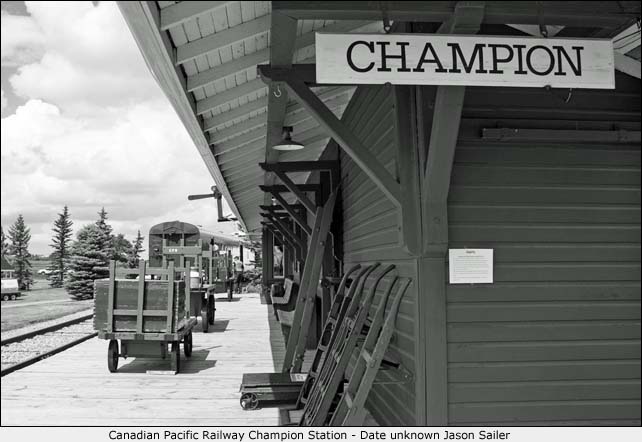
Last week on Saturday, my wife, daughter, and I had the opportunity to check out an "Open House Event" at the Champion Railway Park, located just 5 kilometres northeast of Okotoks, or 7 kilometres straight north of Aldersyde off Highway 2 on the way to Calgary. We, along with countless others, have passed it numerous times and often thought driving by "what is this place?" and "Boy I'd love to get inside to check it out!" Since its inception in the late 1970s and early 1980s it was owned by realtor Background The Champion Railway Park was a private collection of Canadian Pacific Railway (CP) equipment, artifacts, and structures wide ranging from a lowly bunkhouse to the Champion, Alberta, railway station. The whole idea of the Park began in 1979 when Gerald Knowlton wanted to build something as a homage to the Canadian Pacific Railway (partly due to some of the rural train stations being demolished), and also as a family tribute to his parents, Frederick (Ted) and Faye Knowlton. Ted was the station agent at Standard, Alberta, for some forty years. Considering the Standard train station was lost to the wrecking ball, Gerald and some friends went around to five other remaining train stations left standing in southern Alberta to find a replacement for his idea. Out of all left standing, the Champion station was in reasonably good shape and closest to what Ted worked in as a station agent (and what Gerald grew up in as a child). He was able to work out a deal with CP to purchase the former station. While this was occurring, his family scouted around for land to relocate the station onto, and the current 54 acre site of the Champion Railway Park was obtained in late 1979. The Champion station was then relocated to the recently purchased property and left on blocks for a year until a proper foundation could be built. Then the station was moved onto its new supports and a lengthy restoration job began. Gerald's vision was to recreate the environment that his dad was familiar with at Standard, that would mean additional buildings would be needed for the site. Collection Collecting railway buildings (or railway cars for that matter) wasn't easy, but Gerald took advantage of every opportunity CP presented to collect the necessary items for the Railway Park. Using contacts within the industry, additional items and some volunteer labour was obtained to help move the project along. By the mid-1990s the site was mostly developed and an interesting collection of railway equipment was obtained. A section of track, approximately 1/2 mile long, was built out front of the station allowing either the Inspection Car or the 1960s era diesel locomotive to move along the track giving family and close friends rides on the rails. In June 2014, a "Grand Finale Work Party" was held at Champion Railway Park, I had tickets to attend, but couldn't make it to the event. I then gave the tickets to close friends Chris Doering and Connie Biggart, who were itching to get onto the site to document it. They had a great time at the work party, and were able to take some photos. You can read their report here, www.bigdoer.com. By the late 2000s Gerald and his family wanted to slow down and relax a bit so a discussion of the future for the Park came into question. They felt the Park needed a stable future to continue and that the public should have access to it. Discussions with the local municipal district and the neighboring town of Okotoks took place, and by the late summer of 2016 a deal was in place. A handing-over ceremony took place at Champion Railway Park on 16 Sep 2016. The deal called for a joint 50 percent ownership between the MD of Foothills and the Town of Okotoks, with the deal coming into effect on 1 Jan 2017. A non-profit society "The Friends of Champion Park" (comprising former volunteers of the Park, representatives from both municipalities, and interested members of the public) will be formed to take on the maintenance and operation of the Railway Park on behalf of both the MD and the Town. Additionally, the Society will be tasked on the creation of a five-year plan for the transformation of the private park to a public event space. Mind you, transferring land from a private family ownership to a public entity is a lengthy process in its own right with its own set of hurdles to overcome. As well, operating the Inspection Car and locomotive in a public park requires additional Alberta Transportation certification and regulations to be met. I was told at the event that the Town of Okotoks is working with Alberta Transportation on setting up the required paperwork to allow the rail items to be operated by trained volunteers. Both municipalities spent the majority of 2017 evaluating the park to ensure certain standards (i.e. health and safety regulations) are upgraded to allow the public to use the Railway Park. It was also decided that an open house to the public be arranged over the long weekend in August as a "sneak peek" to what the Railway Park can offer. It is hoped that more public events, tours, and educational opportunities will be added over the next five years. But now for the Open House Event. Open House Event Tour Surprisingly, I found out about the open house on Facebook on the day before the event was to take place. Reading the event description, it talked about RSVPing for a seat on a bus that would take us from the Okotoks Recreation Centre over to Champion Railway Park. (There isn't enough parking on the site). It also mentioned the bus seats were already 75 percent claimed, so I quickly found the phone number of the Town of Okotoks and after talking to a representative, she walked me through the online booking process and I was able to secure 3 tickets (all free of course) for a 11:45 trip. Awesome! Saturday morning, we left Lethbridge early enough to make a 2 hour drive to Okotoks. At the Recreation Centre we loaded onto school buses and took a 15 minute drive over to the Railway Park where we were dropped off and then left to tour. The majority of the crowds on the site seemed to be around the Champion train station, so we decided to go to the south end of the Railway Park first and then go northwards. The first stop going south along the train track was a unique design steel-bodied In front of CP 19 was a 1955 United Kingdom built Wickham Inspection car number M-100 with two man carriers. The man carriers included seats to take employees to the work site, now it would take visitors on tours. After looking over the railway equipment we walked over to the section house and checked it out. Afterwards we went to the Engineer Inspector Communications building (I like the pebble glass on the door!), then a bit farther along we reached the railway bunkhouse. The bunkhouse had a familiar look, as we have two at the Galt Historic Railway Park that were originally from Coutts, though the Champion examples are finished and filled to the brim with railway artifacts. A building like this would have been located at strategic points along a track and would have been used by railway employees for sleeping and living accommodations while working on the railway. Not far away was the typical prairie outhouse, and a bit farther away a small square building situated next to the track with Conrad mounted on the side of it. I had heard that the Railway Park had obtained the original Conrad train station and here it was. Peering inside the window it was pretty basic, a stove and some benches to sit on, that's it. On a side note beside the Conrad station was a semaphore signal mounted on a tall pole. I don't think it would have been the same setup at Conrad, but without seeing a historic photo of it in operation, it's hard to say. It is interesting to see nevertheless. A bit father south of the Conrad station was a speeder shed, a general storage shed, boxcar, tank car, and stock car. The wooden metal-braced boxcar (CP 236220) dated back to 1920, along with the tank car (CP 400304) which was from 1923. The double deck wooden stock car (CP 278522) was a newer design from the 1950s. We then walked the track back towards the train station, pausing at the grade crossing to see the vintage wig-wag. The wig-wag was a early type of warning device from the turn of the twentieth-century. As a train approached the arm, with attached warning light, would swing back and forth while the bell above the arm would sound off, warning drivers that a train was approaching. Following the paved pathway down towards the lake we had our picnic lunch. It was very relaxing sitting by the lake eating lunch and watching the ducks float on the water. Afterwards, we walked up the hill towards the restored mail-express car and a business car. We were given a tour of the mail-express car by one of the Park volunteers. The car CP 3622 was built by Canadian Car & Foundry in January 1947 entering service with CP not long afterwards. CP sold the car off in the mid 1980s when it travelled north to the Alberta Railway Museum for a spell. It then went to the Museum of the Highwood near High River in 2002 as part of their railway display for a time, before Champion Park purchased it in June 2013. Some renovation work was done on the car after it arrived at the Park, but it was in relatively good shape. When you step inside the car you definitely feel you are in a Railway Post Office (RPO) car. After the tour, we walked back outside and down the track a bit to the business car. The business car Saskatchewan was built in December 1929 at CP's Angus shops in Montreal, Quebec. The "Saskatchewan" was used to move CP management personnel around the country. It is well appointed and filled to the brim with high quality wood, carpet, and velvet materials. Inside includes a living area, bathroom, five bedrooms with separate bathrooms, a dining area, and a compact galley. I could imagine myself living in a railcar like this! On the end of the car is a spacious covered observation deck where people could sit and watch the passing scenery. The Champion Railway Park acquired the "Saskatchewan" in the early 1980s. Next we walked through the vestibule into the rear of a mail-express car, where another Park volunteer greeted us and gave us a brief explanation of the car, basically a down sized baggage car. I was surprised how detailed the interior was, for just being a basic baggage car. All the correct period items were mounted inside in the right locations, no detail was overlooked, and that little bit of attention I appreciated. We then headed towards the final spot on the tour, the restored Champion train station. Based on the CP Station Number 5 Plan, the Champion station was built for the hefty sum of $4,500 dollars in 1911. Walking in the first door was a compact waiting room complete with vintage CP posters on the wall and a ticket sellers window. Peering inside, we could see the operator's area with the telegraph key (in this case a "bug"). Through the open door on the opposite wall we could see down the hallway into the freight shed. We then walked outside on the platform, past the bay window, and stopped by another door that led upstairs to the living quarters, now occupied by people that look after the Railway Park in the off season. A bit father down the platform was a large sliding door open to the freight shed where a Park volunteer was giving demonstrations on how to "hoop" train orders to train crews. At this time, we realized we were one of the last public visitors still at the Park. Town employees and Park volunteers were cleaning up and taking stuff down for the day so we decided we better head to the bus loading area to head back to our car at the Okotoks Recreation Centre. I wished we could have stayed a lot longer, but it was a hoot nevertheless. My friend B.J. Errson, who is one of the many Park volunteers, signed me up for future work parties, so I look forward to returning and hopefully riding in the CLC locomotive. Thanks to both the MD of Foothills and the Town of Okotoks for stepping up to take over the reins from the Knowlton family, it is greatly appreciated! 17 Sep 2016 - Historic Trains Station and Land Donated to Town of Okotoks... 23 Dec 2016 - Railway Tribute Gifted to Community 7 Aug 2017 - New Functioning Railway Park South of Calgary Brings...  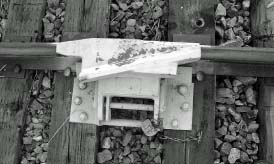 Although extremely damaging to the wheels and track, derails protect people and operations from free rolling and uncontrolled rail cars and equipment. They do this by guiding the flange of the wheel over the rail, so that the wheels drop onto the ties and ballast. This article is copyright 2017 by the Canadian Pacific Railway and is reprinted here with their permission. All photographs, logos, and trademarks are the property of the Canadian Pacific Railway Company. 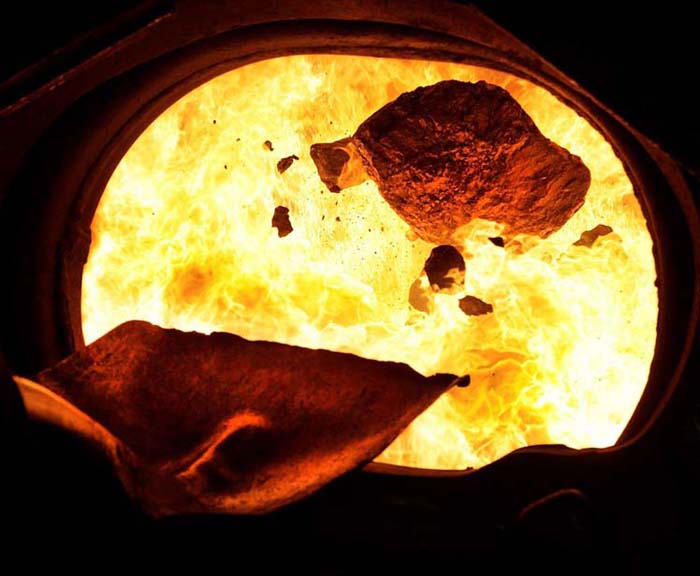 For nine days in January 1957, a walk-out by the Canadian Pacific Railway's firemen paralysed transportation on one of the country's major railways. In Saint John, New Brunswick, City Council declared a state of emergency. With ninety percent of the cit's port traffic dependent on the CPR, Mayor W.W. Macaulay feared that a lengthy strike would turn Saint John into "a ghost city". Sixty-five thousand railway workers were off the job. In Northern Ontario, one thousand workers were laid off at the Lakehead ports. Calgary reported 1,500 men idle. British Columbia miners, Saskatchewan farmers, and several thousand other Canadians were directly affected by the confrontation between CPR management and the Brotherhood of Locomotive Firemen and Enginemen. The issue was technological change. 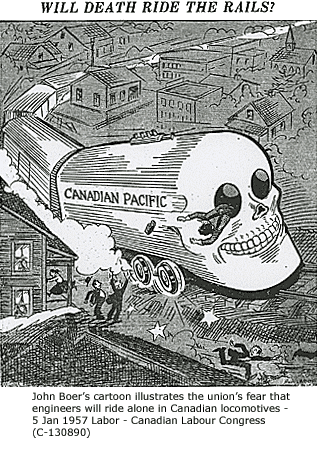 The "diesel issue", as the dispute became known, started with the CPR's plan to introduce diesel locomotives on all trains and to eliminate the firemen's job on all yard and freight service. For the 2,800 firemen on the CPR, this plan struck directly at their jobs and their union. As union spokesman W.E. Gamble stated before the federal conciliation board reviewing the issue, the plan would mean that "firemen are to give up their jobs, see their craft die, and their organization disappear". The Brotherhood of Locomotive Firemen and Enginemen claimed that the firemen were essential to public safety because, as apprentice engineers, they were the engineer's "co-pilot". The CPR was equally determined to take full advantage of the lower operating costs offered by the new technology. With the introduction of diesel locomotives on all trains, the company could save an estimated $11.5 million per year. The CPR argued that the firemen, who were once required to stoke the engine by hand, had been made redundant by changing technology. Hand-fired locomotives gave way to automatic stokers, oil-fired steam engines and finally the diesel. The company offered to find other jobs for most of the firemen, but their long history with the railways of Canada had come to an end. With both union and management adamant in these positions, a long disruptive strike was feared. Through the efforts of the Canadian Labour Congress and the federal minister of Labour, however, a temporary solution was found. The firemen would return to work, the CPR would delay its plan, and the federal government would establish a Royal Commission under Supreme Court Justice R.L. Kellock to examine the "the diesel issue" and its effect on public safety. The Royal Commission on Employment of Firemen on Diesel Locomotives in Freight and Yard Service on the Canadian Pacific Railway conducted an extensive investigation from January to November 1957, hearing testimony of 119 witnesses and visiting European countries to examine their experience with diesel locomotives. Although the decision of the Royal Commission was not binding on either party, its decision did shape public opinion. On 4 Feb 1958 Kellock issued his report. The firemen, the Commission concluded, were not necessary on the diesel locomotive and the CPR plan would not endanger public safety. The company offer to find other jobs on the CPR for the current firemen was judged to be fair compensation for the employees. The decision was a severe blow to the union. Unable to accept its demise without a fight, the Brotherhood launched a second strike in May 1958. With public opinion against the firemen and the trade union movement offering only weak support, the CPR kept its lines operating. After three days, the union called off its strike. The failure of this strike was important, since the CPR example was soon followed on other North American railways. Brotherhood of Locomotive Firemen and Enginemen members picket outside of Montreal's Windsor Station - January 1957 Photographer? - Montreal Gazette (C-160808). The archival record created by this dispute provides a good source for the historical study of technological change. The union case is found in the records of the Brotherhood of Locomotive Firemen and Enginemen, now part of the United Transportation Union records (MG28I219) and of the Canadian Labour Congress records (MG 28 I 103). The government records relating to the "diesel issue" are found in the Department of Labour (RG 27) and in the transcript and exhibits of Kellock's Royal Commission on the Employment of Firemen on Diesel Locomotives (RG 33/37). For many Canadians in the 1950's, the "diesel issue" illustrated the problems surrounding the introduction of new technology. Thirty years later, technological change has taken a new form, but the social debate about its implications remains constant. OKthePK Joint Bar Editor: Ironically, 56-years-later, as a result of the Lake Megantic tragedy, Transport Canada changed the rule to require a two man crew on diesel locomotives. Once Positive Train Control (PTC) is completely installed in the United States there is every likelihood railroad management will once again want to do away with two man crews on locomotives. Will Canada follow? You can read the The Kellock Commission Report of the Royal Commission on Employment of Firemen on Diesel Locomotives in Freight and Yard Service on the Canadian Pacific Railway at this link. 
Canadian Pacific Railway 60-Ton Hopper Bottom Box Car 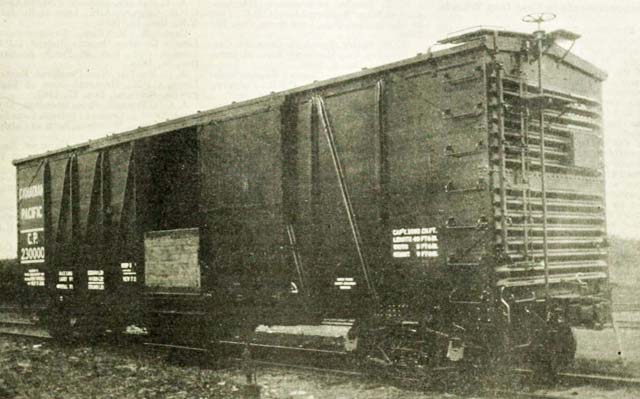 Sixty Ton Hopper Bottom Box Car, Canadian Pacific Railway. As stated in Canadian Railway and Marine World, when the orders were placed last spring and summer, the C.P.R. is having 3,500 sixty-ton hopper bottom box cars built. Hoppers are being provided at the side door openings, as a result of very satisfactory service having been obtained from 200 cars similarly equipped which were placed in special service between Port McNicoll and West St. John, New Brunswick, commencing October 1911. The general dimensions are as follows: Type .................................. Single sheathed, steel framing Length inside ......................... 40 feet 6 inches Width inside .......................... 8 feet 6 inches Height inside ......................... 9 feet Height from rail to top of floor ...... 3 feet 7 inches Width of door opening ................. 6 feet Capacity in cubic feet ................ 3,098 cubic feet (exclusive of hoppers) Light weight .......................... about 48,300 pounds Maximum lading ........................ about 120,700 pounds Limit load 5 1/2 x 10 inch journals ... 169,000 pounds Ratio lading to weight of car ......... 71.4 percent
Underframe - The center sills are composed of two 12 inch 35 pound ship channels, tied together by 1/4 x 20 inch top cover plate. Steel striking casting, coupler carrier, draft lugs, and center brace are used. The bolsters are made up of 5/16 inch pressed steel diaphragms, riveted to center and side sills, and covered top and bottom by 14 x 5/8 inch plates. The crossbearers are made up of 1/4 inch pressed steel diaphragms, riveted to center and side sills, and covered at top by a 6 x 7/16 inch plate and bottom by a 6 x 3/8 inch plate. The underframe is fitted with four crosstie webs or stiffeners, pressed from 1/4 inch plate. Two of these stiffeners are located between each bolster and crossbearer. Between the center sills at each crossbearer and stiffener a 1/4 inch pressed diaphragm is used. Side Framing - The side plate is a special rolled angle 6 x 3 1/2 x 3/8 inch, having an 87 degree root angle. The posts and braces are U shaped, pressed from 1/4 inch plate, flattened at side sill and plate, to provide large riveting surface. The side sill is 9 inch, 17.5 pounds per foot. The door posts are made of 4 inch 8.2 Z bars. The side doors represent what is believed to be the best obtainable. The interlocking front and back edges afford exceptional protection against weather and pilfering. The top edge is thoroughly weatherproof, yet so arranged that it cannot become blocked with ice. The bottom of the door is fitted with turned rollers, that fit on very substantial and rigidly supported track. This track is not likely to be blocked with ice, but in case it should be, the interference is plainly visible and easily removed. The location of rollers at the bottom of the door does away with the binding, or cramping, so frequently noticed on doors suspended from the top. The grain hoppers, located at the side door opening, on each side of the car, are the Burnett type. When used for freight that cannot be dumped through the hopper, the car has a solid level floor the same as an ordinary box car. When grain, coal, etc., are to be loaded the specially constructed sections of the floor over the hoppers are turned up against the side door posts. This arrangement allows the load to go directly into the hoppers, and also saves considerable temporary door lumber. When the cars are unloaded, it is only necessary to remove the pin that locks the hopper doors, the doors open quickly by gravity and immediately a large percentage of the contents of the car discharges through the hoppers. The balance of the load may be shoveled to the middle of the car by hand, or if the unloading plant is equipped with power shovels, as most elevators are, the floor door on one side of the car is released from the door post, and the cables taken through the door opening as usual. The hopper doors have no operating mechanism, they are closed directly by hand and secured by simple locking bar arrangement. End Frame - Murphy horizontal corrugated ends, in two pieces, are used. The top section is formed to secure ample connection to side plates, and provide a very strong end plate. The bottom edge of the end is securely riveted to a 6 x 4 x 1/2 inch angle forming end sill, which is in turn securely fastened to side sills and diagonal braces as well as center sills. Roof - Murphy outside metal roofs, with 13/16 inch tongue and groove boards, laid longitudinally, are used in connection with strong Z bar carlines, providing ample supports at side plates. Part of the cars are equipped with angle type carlines. Lining and Decking - The side and end lining is 1 1/2 x 5 inch tongue and groove and must show more than 6 percent decrease in weight, after being placed for 96 hours in a hot cupboard, the temperature of which is maintained at from 160 to 180 degrees Fahrenheit. The lining, after being milled, is dipped in paint and dried before application. The decking is 2 1/4 inch thick, and securely bolted to 1/8 inch plate at side sills, and fastened to center sills by floor clips. The specialties used are: Dust guards ...................... Thornburg Journal boxes .................... McCord 5.5 x 10 inch round bottom Brake beams ...................... M.C.R. No. 2 Four point suspension ............ Creco Truck bolsters ................... Simplex Side bearings .................... Stucki Draft gear ....................... Murray Type H, Class 25 Doors ............................ Camel, bottom hung Roof ............................. Murphy, outside metal Uncoupling device ................ Imperial Type B Brakes ........................... Westinghouse schedule KC 1012 Parking cups and expander rings .. Johns Manville Coupler yokes .................... Cast steel 
A Canadian Pacific Railway metal cast beaver logo from the "Canadian" sold by CP Bygones - Date? William Slim. In 1971 the railway created "CP Bygones", a project by Omer Lavallee, long-time historian and Corporate Archivist who was in charge of CP Bygones. Prior to CP Bygones' first travelling sale in 1971, Omer Lavallee (right) shows then-Chairman of Canadian Pacific N.R. Crump a selection of items to be disposed of by sale to collectors - Date? Photographer? - CP. In the early 1970's the railway created "CP Bygones", a project by Omer Lavallee, long-time historian and Corporate Archivist, who was in charge of CP Bygones. The company produced a catalog of various collectable items that were sold across Canada including, beaver crests, silverware, blankets, lanterns, and even steam locomotive bells! (I recall the bells were pretty expensive at the time.) The beaver logos that were once attached to their flagship train, "The Canadian", could be purchased for the price of $10. I wonder what you would have to pay today if one ever came on the market? I'm sure there are railfans out there who have one squirreled away somewhere in their basement. Here are some photographs of a number of Canadian Pacific Railway collectables I've come across over the years. 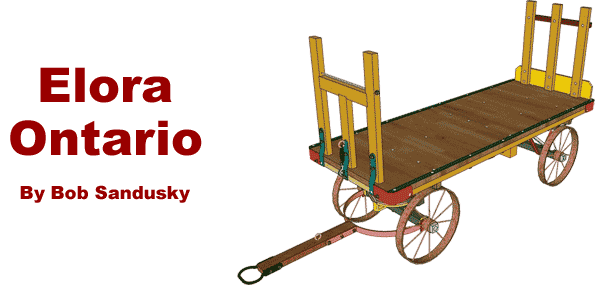 Elora Ontario - There was an interesting (though very informal) switching practice that occurred at Elora on occasion. There was a slight downgrade on the main track from the first switch at the beginning of the yard, which became level again when the freight shed was reached (and the station just past that). Quite often when the only arriving consist was the combine, it would be detached and parked at the top of this slight incline while the loco would move off to a side track. The conductor would then man the handbrake on the combine, and with gravity, coast it down into the station. Canadian Pacific 4-6-0 class D10 number 963 rides the turntable at Elora while the conductor can be seen braking combine 3351 down past the freight shed to the station - 8 May 1954 Bob Sandusky. This saved time and meant for a longer lunch break before the return journey. A year later this second photo shows North British built number 526 on the turntable but this time no combine coasting. Just peeking out to the left of the locomotive is the end of business car 35. It had been attached to the mixed from Orangeville this day so everything was by the book. Canadian Pacific 4-6-0 class D10 number 526 is turned on the turntable while the corner of business car number 35 is barely visible - 28 Jun 1955 Bob Sandusky. Bob Sandusky - 22 May 2018. |

